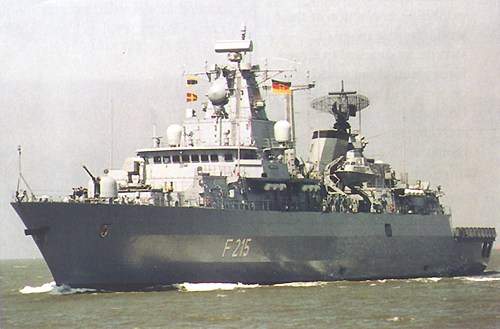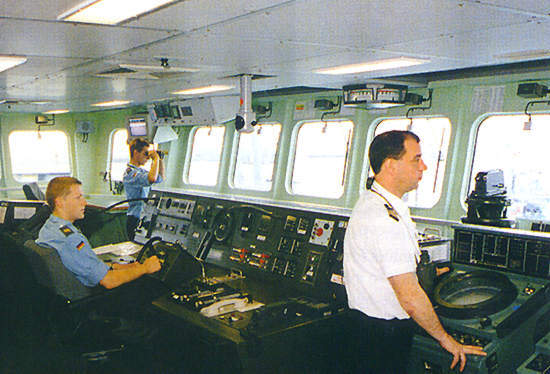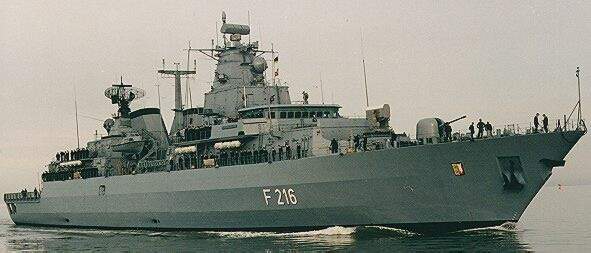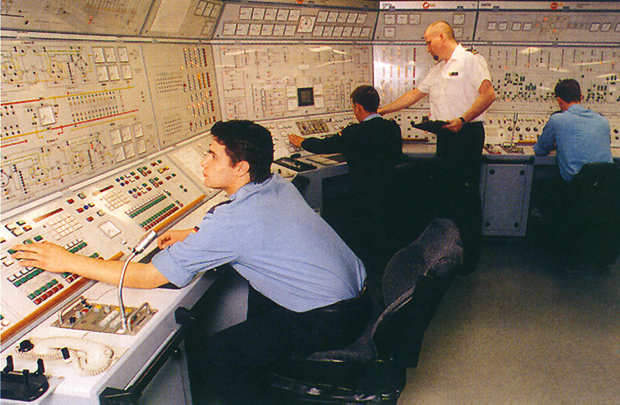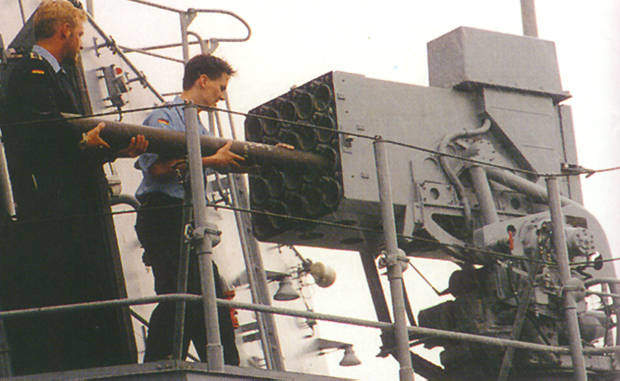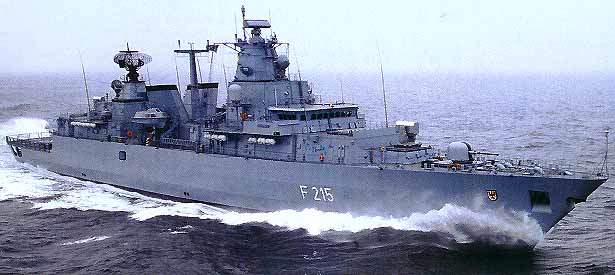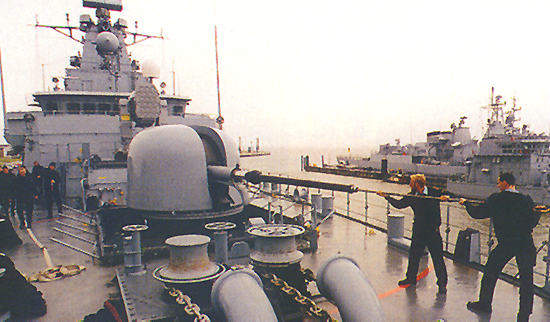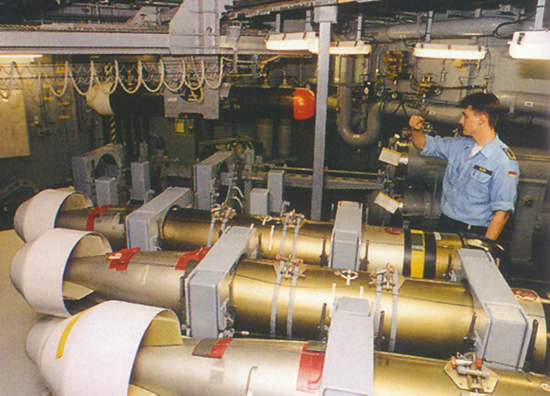The Type 123 Brandenburg Class frigates were ordered in June 1989 to replace the Hamburg Class. The frigates are primarily tasked with anti-submarine operations, but they also contribute to anti-air defence, the tactical command of group forces and surface operations. The ships form part of the Wilhelmshaven-based 6th frigate squadron.
Drawing on the experience of the aborted ‘Nato frigate for the nineties’ project and the construction of the German Type 122 multi-mission frigate, as well as German modularisation techniques, Hamburg shipbuilders Blohm + Voss developed a combined Meko and improved serviceability Type 122 design.
The all-steel ship has stealth features, extra space for task group personnel and fin stabilisers. It is designed to carry two AgustaWestland Sea Lynx mk88 helicopters and a rigid inflatable boat for boarding operations.
The first ship, Brandenburg (F215), was built by Blohm + Voss and commissioned in October 1994; the second, Schleswig-Holstein (F216), was built by Kiel-based shipbuilder Howaldtswerke and commissioned in November 1995; the third, Bayern (F217), was built by Emden-based Thyssen Nordseewerke and commissioned in May 1996; and the fourth, Mecklenburg-Vorpommern (F218), by the Bremen-based builder, Bremer Vulkan, commissioned in November 1996.
Brandenburg Class frigate design
The Brandenburg has a displacement of 4,700t fully loaded and an overall length of 138.9m. The ship has a maximum speed of 29kt using the gas turbines and 18kt using the diesel engines, with a range of 4,000nm at 18kt. The ship can accommodate 118 crew (including 19 air crew).
Command and control
The combat data system is built around the Atlas Elektronik / Paramax SATIR action data automation with Unysis UYK 43 computer, Link 11, and Astrium (formerly Matra Marconi) SCOT 1A satellite communications. Weapons are controlled by a Thales Nederland (formerly Signaal) MWCS system with two optical sights.
The German Navy began a common upgrade programme for the combat system on the four Brandenburg and eight Bremen Class (F122) frigates. A contract was awarded to Thales in September 2005 to provide a new open architecture system to replace the SATIR.
The upgrade was completed in 2011. IBM is supplied and installed the Link 16 capability enhancement and also installed the EADS defence electronics multifunctional information distribution system (MIDS).
Frigate weapons
The ship is armed with two twin launchers for MM38 Exocet surface-to-surface missiles, from MBDA (formerly EADS Aerospatiale). Exocet has inertial guidance with active radar homing and a range of 42km. A Lockheed Martin mk41 mod 3 vertical launch system for 16 Nato Sea Sparrow medium-range surface-to-air missiles is fitted.
Sea Sparrow has semi-active radar terminal guidance and a range of 14.5km.
The ship also has two 21-cell launchers for the RAM (rolling airframe) short-range surface-to-air missile The RAM missile has infrared guidance and a range of 9.5km.
The vessel is equipped with one Oto Melara 76mm / 62 mk75 main gun, which has a firing rate of 85 rounds a minute and range of 16km anti-surface and 12km anti-air, and two Rheinmetall 20mm Rh 202 guns. The Rh 202 guns are set to be replaced by the new Mauser MLG 27 light navval gun system, which can fire FAPDS (frangible armour-piercing discarding sabot) ammunition.
Two twin 324mm mk32 torpedo tubes are fitted for ATK (AlliantTechsystems) mk46 active / passive anti-submarine torpedoes.
Brandenburg countermeasures
The electronic warfare suite includes the FL 1800 S-II electronic support measures and countermeasures system, developed by DaimlerChrysler Aerospace, now EADS Systems & Defence Electronics. Two Oto Melara SCLAR decoy dispensers are fitted for chaff and infrared flares.
In January 2007, Schleswig-Holstein (F216) was fitted with four launchers for the Rheinmetall Waffe Munition MASS (multi-ammunition softkill) decoy system for the vessel’s deployment as part of the UNIFIL UN mission monitoring the coast of Lebanon in April 2007.
The MASS decoy covers radar, infrared, electro-optic, laser and ultraviolet wavebands. In June 2007, Rheinmetall was contracted to supply MASS for the other three vessels, the work to be completed by 2009.
Sensors
The air / surface search radar is the Thales Nederland SMART 3D radar operating at F band. Air search is performed by Thales Nederland LW08, D-band radar. Two Thales Nederland STIR 180 tracking radars for fire control and two Raytheon Redpath I-band for navigation are also fitted.
The Atlas Elektronik DSQS-23BZ hull-mounted medium-frequency search and attack sonar is supplemented by a low-frequency active sonar system (LFASS) towed array.
In March 2007, EADS Defence Electronics was contracted to supply the MSSR 2000 IFF Mode S information friend or foe (IFF) system for installation on Schleswig-Holstein (F216) for the UNIFIL mission off Lebanon.
In November 2007, EADS received a contract to equip the other four Brandenburg vessels with the system.
Propulsion
The ship is powered by a CODOG (combined diesel or gas) plant of two GE 2500 gas turbines, each rated at 33,600hp with a power turbine speed of 3,600rpm, and two MTU ZOV956 TB92 diesel engines, each developing 6,568hp at 1,500rpm, driving two shafts with controllable-pitch propellers.

